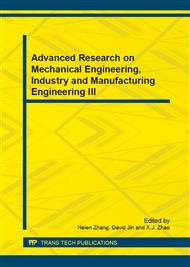p.469
p.473
p.477
p.482
p.486
p.494
p.498
p.502
p.507
Multi-Objective Optimization in Manufacturing Engineering for Slender Pen Rod Injection Molding Quality Based on Grey Correlation
Abstract:
In this paper a new approach for the optimization of the multi-objective injection molding process based on the Taguchi robust design combined with the grey relational analysis has been studied. A grey relational grade obtained from the multi-objective grey relational analysis is used to solve the injection molding process with the multiple performance characteristics including volume shrinkage (R1) and axial deformation (R2), the injecting parameters, namely mold temperature, melt temperature, holding pressure and holding time are optimized. By orthogonal polar difference analysis and statistical analysis of variance (ANOVA) of grey relational grade, main factors influencing and the best process parameters were determined: A=50°C,B=250°C,C=30MPa,D=9s.Under the case of continuity factor, Fitting the response surface further the optimal combination of in continuous space r is identified: A=50.3°C,B=250°C,C=29MPa,D=8.3s. Experimental results have shown that the Taguchi combined with the grey relational analysis can avoid human evaluation of the multi-objective optimization, and Injection molding multi-objective optimization is implemented more objectively, and product performance in the process can be improved effectively through this approach.
Info:
Periodical:
Pages:
486-493
Citation:
Online since:
August 2013
Authors:
Price:
Сopyright:
© 2013 Trans Tech Publications Ltd. All Rights Reserved
Share:
Citation:


